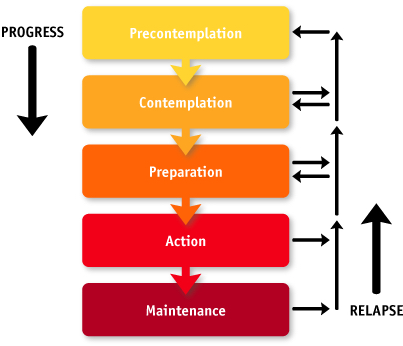Nancy J. Abel, LCSW, LADC and John M. O’Brien, Ph.D, authors of “Treating Addictions With EMDR Therapy and the Stages of Change
,” point out some new methods that have proven to be effective for EMDR therapists in learning how to help their clients who are struggling with addictions. One of the key elements that they emphasize in their book is developing a positive relationship between the client and therapist so that clients can move through the Stages of Change successfully. There are 5 Stages that are talked about in this book:
- Pre-Contemplation
- Comtemplation
- Preparation/Determination
- Action
- Maintenance
Let’s take a brief look at these different stages of healing.
- Pre-Contemplation: The first stage Able and O’Brien cover in their book, is the stage of Pre-Contemplation. This is the stage where clients have not yet thought much about making a change around their addiction. The therapist’s job is to help point the client in a direction of wanting to make changes.
- Contemplation: Once the client has some idea of the change they would like to make, the client has moved into the next stage of treatment, which is Contemplation. Contemplation is the stage where a client is now willing to discuss things that they previously were not willing to discuss and are more open to making some change. This is a beginning or opening for thoughts of change. Clients begin to question their use of a substance by looking at the positive and not so positive experiences related to their addiction. Ambivalence is a part of this stage. The therapists job is to help the client recognize this ambivalence and prepare the client for the next stage; Preparation/Determination.
- Preparation/Determination: Preparation/Determination is where actual change for the client begins to enter the discussion. Steps are talked about of how to take action to making change a reality.
- Action: Next, the client is moving into the stage of Action. Action is where the client actually takes the steps previously talked about so that change can begin.
- Maintenance: The last stage of this process is Maintenance. This is the stage where clients work on maintaining their recovery and preventing relapse from occurring.
 In some types of addictions therapy confront the client with their addiction, as well as, requiring clients to abstain from their addictions. In their book, Abel and O’Brien challenge the method of confrontation as the focus of treatment. That is, they emphasize treatment methods that focus on allowing clients to struggle with ambivalence in certain stages of change. This process of sitting with the ambivalence helps clients make their own decisions, which is beneficial in the long run for the success of their treatment.
In some types of addictions therapy confront the client with their addiction, as well as, requiring clients to abstain from their addictions. In their book, Abel and O’Brien challenge the method of confrontation as the focus of treatment. That is, they emphasize treatment methods that focus on allowing clients to struggle with ambivalence in certain stages of change. This process of sitting with the ambivalence helps clients make their own decisions, which is beneficial in the long run for the success of their treatment.
Abel and O’Brien also challenge the idea of abstinence. That is, that while abstinence may be a reasonable and a desired goal; working with harm reduction can be an effective way through the process in the stages of change.
The exciting part of this book is that they also include the process of using EMDR Therapy as a way to help people struggling with addictions. Working with EMDR Therapy for Addictions can be multilayered. By taking a thorough history — and once there is an understanding of where a client is in the stages of change — one can then make an educated decision as to where EMDR therapy can best serve the client.
One of the essential parts of EMDR Therapy is working with trauma. Trauma has been found to be an underlying factor that contributes to many addictions. Many times when clients heal the childhood trauma, the drive for the addictive behavior decreases. Abel and O’Brien share different ways of applying EMDR Therapy to help clients receive best treatment results.
If you are a therapist looking to gain more skills in working with addictions, Barb Maiberger and I are offering “EMDR Therapy Tools for Addictions.” This two-day training emphasizes the importance of recognizing trauma in addictions work. Practical exercises are explored to help clients move through the stages of change using EMDR Therapy. If you would like more information on how to use EMDR Therapy with addictions, I encourage your to attend our training, and to read “Treating Addictions With EMDR Therapy and the Stages of Change.”
EMDR Therapy Tools for Addictions EMDR Training Schedule EMDR Therapy Books
Guest Blogger: John Gray, MA, LPC, CACIII
 This blog post was written by guest blogger, John Gray, MA, LPC. John Gray is a Certified EMDR Therapist and Consultant. John has fifteen years of experience as a psychotherapist. With his ten years of experience as a University Instructor of Sociology and Psychology, he brings a unique perspective to his work. His experience in how we develop a sense of self and maintain this sense of self through various methods of interaction forms the essence of his therapeutic approach. John strives to co-create a safe environment for all who choose to embark on the rewarding work involved in taking more control of their lives. He has presented at national and international conferences and continues to guest lecture at colleges and universities.
This blog post was written by guest blogger, John Gray, MA, LPC. John Gray is a Certified EMDR Therapist and Consultant. John has fifteen years of experience as a psychotherapist. With his ten years of experience as a University Instructor of Sociology and Psychology, he brings a unique perspective to his work. His experience in how we develop a sense of self and maintain this sense of self through various methods of interaction forms the essence of his therapeutic approach. John strives to co-create a safe environment for all who choose to embark on the rewarding work involved in taking more control of their lives. He has presented at national and international conferences and continues to guest lecture at colleges and universities.
John Gray’s Website EMDR Therapist Directory Profile
Image Source: “Stages of change model.” by Toddatkins via WikiMedia Commons (CC)






